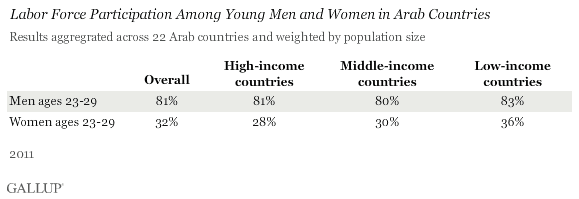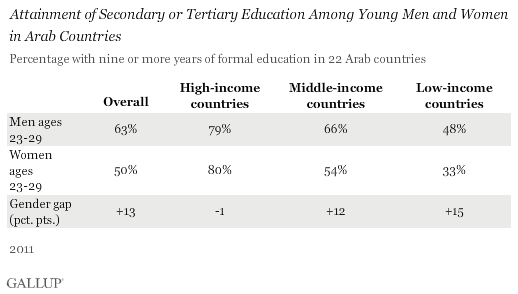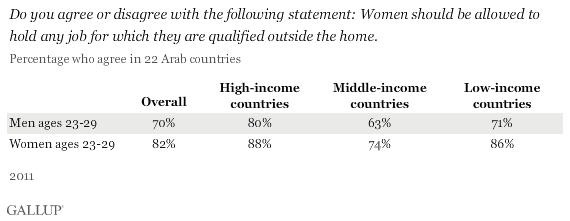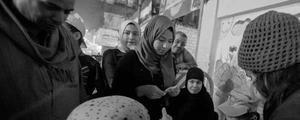WASHINGTON, D.C. -- About one in three young Arab women between the ages of 23 and 29 participate in their country's labor force versus about eight in 10 young Arab men. This gender gap is generally consistent across the 22 Arab countries and territories Gallup surveyed in 2011, but young women's labor force participation is slightly higher in low-income countries than in higher income countries.

These findings are based on a new Silatech Index report, "Workforce Participation Linked to Wellbeing Differences Among Young Arab Women," which examines how young women's workforce participation is related to their life evaluations, emotional state, and economic optimism.
In many Arab countries, chronic job shortages combined with cultural factors, such as pressure on employers to give young men jobs that enable them to marry and start families, may limit employment opportunities for young women. The World Bank recently reported that the Middle East and North Africa region continues to have the lowest female workforce participation rate of any global region.
These broad gender gaps persist despite impressive strides in many Arab countries toward gender equity in education. In high-income countries, women aged 23 to 29 are just as highly educated as their male counterparts and are more likely than young men to have a tertiary education (22% vs. 16%, respectively). In middle-income and low-income countries, young women are less likely than young men to have more than a primary education.

Despite cultural and institutional barriers to women's workforce participation throughout the Arab world, young adults in the region generally support the idea in principle. Most young men and young women in all Arab countries polled agree that women should be allowed to hold any job for which they are qualified outside the home. However, in each case, young men are somewhat less likely than young women to agree.

Implications
Slow-to-change cultural and institutional patterns are one reason why large gender gaps persist in workforce participation among young Arabs. Balancing family-life demands, particularly child rearing, can be challenging for women -- but particularly in countries where laws regarding gender discrimination and benefits for working women (such as maternity leave) are inadequate or loosely enforced.
Structural challenges may also pose significant barriers. In societies where unemployment is high, for example, there may not be enough jobs to support women's widespread entry into the workforce. Women in the job market in these societies may also lack professional female peers to provide mentoring and networking opportunities to them.
Women's low workforce participation represents untapped economic potential for all Arab countries. Even among affluent countries in the Arab Gulf region, leaders are concerned with promoting private-sector job growth and economic diversification. Helping young women access the job market and participate in entrepreneurial endeavors is increasingly important to such development, particularly in countries where most women are well-educated.
For complete data sets or custom research from the more than 150 countries Gallup continually surveys, please contact SocialandEconomicAnalysis@gallup.com or call 202.715.3030.
Survey Methods
Results are based on face-to-face interviews with 7,670 young adults, aged 23 to 29, conducted in the spring and fall of 2011. Surveys were conducted in 22 Arab countries and territories: Algeria, Bahrain, Comoros, Djibouti, Egypt, Iraq, Jordan, Kuwait, Lebanon, Libya, Mauritania, Morocco, Oman, Palestinian Territories, Qatar, Saudi Arabia, the Somaliland region of Somalia, Sudan, Syria, Tunisia, United Arab Emirates, and Yemen.
The sample includes 1,919 respondents in high-income countries, 3,059 in middle-income countries, and 2,692 in low-income countries. For results based on the total samples of young adults, one can say with 95% confidence that the maximum margin of sampling error is ±3 percentage points. The margin of error reflects the influence of data weighting. In addition to sampling error, question wording and practical difficulties in conducting surveys can introduce error or bias into the findings of public opinion polls.
For more complete methodology and specific survey dates, please review Gallup's Country Data Set details.
